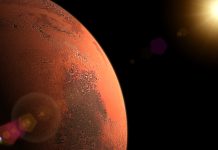![new-technique-from-bro Cropped LOLA LDEM (a), (c) and SfS solution (b), (d) for the Malapert Massif candidate landing region, centered at 85.964°S, 357.681°E on a ridge near the summit of Mons Malapert. Both products show a central east–west ridgeline with primarily north- and south-facing slopes. Two hillshade images match illumination conditions of the low-Sun controlled NAC mosaic with subsolar longitude 315° [(a)–(b), Sun from top left] and 235° [(c)–(d), Sun from bottom left], elevation 5° above the horizon. Credit: The Planetary Science Journal (2024). DOI: 10.3847/PSJ/ad41b4](https://www.openaccessgovernment.org/wp-content/uploads/2024/05/new-technique-from-bro-696x713.jpg)
Researchers at Brown University have developed a method for mapping the surface of the Moon, which will enhance the precision of lunar exploration
The study, published in the Planetary Science Journal, details progress in a mapping technique known as shape-from-shading.
The shape-from-shading techniques
Shape-from-shading involves creating detailed models of the Moon’s landscape by analysing how light interacts with its surface. This technique can outline craters, ridges, slopes, and other surface hazards, supplying valuable data for mission planners.
Accurate maps are crucial for identifying safe landing spots and areas of scientific interest, ultimately contributing to smoother and more successful lunar missions.
“It helps us piece together a better idea of what is actually there,” said Boatwright, a postdoctoral researcher in Brown’s Department of Earth, Environmental and Planetary Sciences and lead author of the study. “We need to understand the surface topography of the Moon where there isn’t as much light, like the shadowed areas of the lunar south pole where NASA’s Artemis missions are targeting.”
How these new mapping techniques provide better results
The traditional process of creating these precision maps is labour-intensive and faces challenges with complex lighting conditions, inaccurate shadow interpretation, and landscape variability.
The researchers at Brown have addressed these issues by implementing advanced computer algorithms that automate many processes, significantly improving the resolution and speed of the models.
“Shape-from-shading requires that the images that you’re using be perfectly aligned with one another so that a feature in one image is in the exact same place in another image to build up those layers of information,” Boatwright explained. “Current tools are not quite in a place where you can just give it bunches of images, and it’ll spit out a perfect product”
The researchers also introduced quality control algorithms and filters to reduce outliers, ensuring the aligned images match accurately. This refinement allowed maps with submeter resolutions, enabling larger areas of the Moon to be examined with greater detail.
The future of these new maps
The accuracy of these new maps was validated by comparing them with existing topographic models. The refined shape-from-shading method produced more precise maps, revealing subtle features and variations on the lunar surface that traditional techniques missed.
The study used data from the Lunar Orbiter Laser Altimeter and Lunar Reconnaissance Orbiter Camera, both aboard NASA’s Lunar Reconnaissance Orbiter, which has been orbiting the Moon since 2009.
The researchers hope their open-source algorithms will be widely adopted, enhancing lunar exploration and science.
“These new map products are significantly better than what we had in exploration planning during the Apollo missions,” said Head, a professor of geological sciences at Brown.










